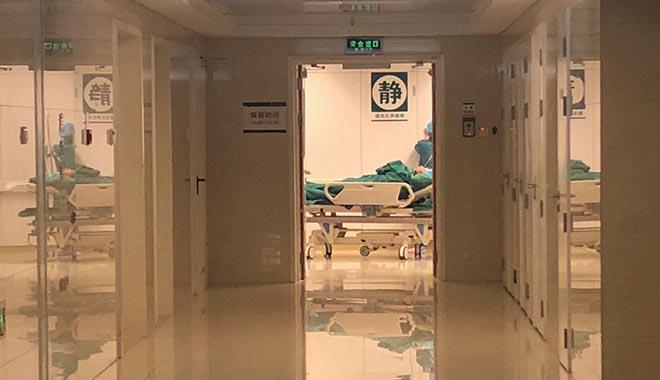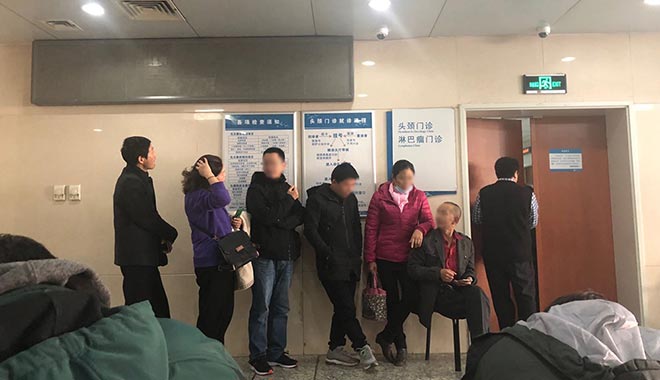The boundary is 0.5cm, who will control the right to speak in life?
Cctv news(Reporter Liu Chang Zhang Ke): The following is a set of data that may cause discomfort. According to the statistics of the National Cancer Registry, the incidence of thyroid cancer in the world has increased by 6% every year in the past 10 years, and it has become the fastest growing malignant tumor. According to the latest analysis report on the prevalence of malignant tumors in China completed by the National Cancer Center, thyroid cancer ranks seventh in the incidence of malignant tumors in China with the incidence of 201,000, and now ranks fourth in the incidence spectrum of female malignant tumors.
Why does this "butterfly" on the neck cause such a big effect? In the face of thyroid nodules, do we treat them or not? How? How should we face thyroid "microcarcinoma"? These seemingly professional medical problems test not only doctors. Because medicine has never been limited to medical problems.
Anxiety begins with a physical examination.
Due to the increasing incidence of thyroid cancer in the past two years, Chen Yibai’s unit has added thyroid ultrasound examination to the annual routine physical examination since last year. After receiving the physical examination report, I saw that it said "thyroid nodule, blurred boundary, visible calcification." It is recommended to go to the hospital for further examination. " This coincides with what Dr. B-ultrasound emphasized on the day of physical examination. A few days later, Chen Yibai went to a hospital close to home and registered for another ultrasound examination. After getting the results, the doctor highly suspected thyroid cancer and suggested that he have a puncture examination.
The puncture was invasive, and Chen Yibai was anxious. Mother suggested that he go to two or three more big hospitals. He went to a well-known hospital in the local area. When the doctor read the B-ultrasound list, he suggested that he go to the hospital directly, and he opened a puncture list without hesitation. He couldn’t figure it out. He didn’t feel any discomfort. Only one routine physical examination actually made him go to the hospital for surgery.
After much consideration, Chen Yibai decided to do ultrasound-guided puncture examination first, and determine the benign and malignant nodules through pathological diagnosis before considering whether to operate.
Some thoughts stay at the next node.
Xiaosu has also undergone physical examination and puncture, but she has been diagnosed with thyroid microcarcinoma. Because the tumor is less than 0.5 cm in diameter and is in the capsule, the doctor suggests dynamic observation. Xiaosu has always been worried. Although the doctor does not recommend immediate surgery, it is a malignant tumor after all, just like a time bomb that will explode. No one knows when it will grow up, whether it will metastasize or not, and what it will bring to itself … …
With the development of science and technology, the technical level of medical imaging has been continuously improved. Some scholars believe that the increasingly sophisticated examination instruments are one of the main reasons for the high detection rate of thyroid cancer. More doctors believe that the increase in the number of patients with thyroid cancer is caused by comprehensive factors, including environment, stress and bad living habits, as well as insufficient popularization of thyroid cancer prevention work and insufficient public attention.
However, after thyroid cancer is detected, almost no one can be calm and calm, and cutting it off and cleaning it is the choice of most people.

"Rebirth" after operation
Tangent or not, where is the node?
A dozen cases with 10 cm thickness, broken edges and yellowed paper tell the 15-year history of an 80-year-old man’s struggle with thyroid nodules. The word "fight" is used because the old man thinks that as long as there is a lump, it must be removed, even if it is benign, and we must fight it to the end!
So, in 15 years, the old man had three operations. Until the age of 80, when the recurrence was diagnosed again, her son finally shouted "stop". "The location of this tumor is not good, and our local hospital does not give surgery. So we came all the way to Beijing. " When I saw Dr. Liu Yuewu, the old man’s son kept asking, can I have surgery? The reason is that the old man feels that if he doesn’t have surgery, he will not be far from death.
For Liu Yuewu, a professor at Peking Union Medical College Hospital who has to perform nearly 500 cases of thyroid diseases every year, this operation is still not as simple as "removing the disease under the knife". "Surgery has strict indications, not if you want to do it."
Liu Yuewu turned over the cases of the old man for more than ten years and frowned. "It is relatively taboo that thyroid tumors are treated surgically regardless of benign or malignant." He pointed out that some benign nodules will not cause harm to the body, and benign nodules have one characteristic — — Multiple. "There may be three nodules in the thyroid gland this year, and seven or eight may grow in three to five years, so this kind of nodule is multiple. If surgery is performed as soon as a nodule appears, then multiple operations may be performed. " Liu Yuewu said that with the increase of the number of operations, it will bring unexpected injuries, especially the injury to the recurrent laryngeal nerve, resulting in hoarseness.
"Generally speaking, thyroid nodules diagnosed as malignant tumors by color Doppler ultrasound or fine needle puncture should be treated surgically." Liu Yue Wujin further said that with the in-depth understanding of thyroid tumors, some small thyroid cancers (below 0.5 cm) and in the capsule (thyroid), if patients are unwilling to have surgery, they can choose dynamic observation, generally review color Doppler ultrasound once every six months, and decide whether to operate according to the changes of nodules. If this small thyroid cancer chooses dynamic observation, it must also meet the following conditions: First, it is not close to the thyroid capsule, recurrent laryngeal nerve, great blood vessels and trachea. If the tumor is close to these organs and tissues, it will invade them and bring harm to the body. On the contrary, if the tumor is small and located in the center of the thyroid gland, that is, completely in the thyroid capsule, such tiny cancer is not easy to metastasize and invade the surrounding important organs. In this case, if the patient is unwilling to have surgery, he can choose dynamic observation.
In the end, Chen Yibai diagnosed the nodule as malignant and grew to 2 cm. He chose surgery. Xiaosu listened to the doctor’s advice and continued to observe dynamically; The 80-year-old man did not have another operation because he was clinically diagnosed as a benign nodule. All the choices are made by the patients and their families, and the premise is that they understand all the professional statements of the doctor about the disease.

At 2 o’clock in the afternoon, the half-day clinic time of the head and neck clinic in a hospital has ended for nearly two hours. The electronic screen of the hospital’s call system has been closed, and there are still people waiting in line in the waiting area, waiting for the doctor to "call the number manually".
Early diagnosis and treatment? How to "do what you can"
In the last ten years, papillary thyroid carcinoma has grown the fastest, among which the early cases of papillary thyroid carcinoma with a diameter less than 1 cm have increased the fastest, with an increase of 25% in the last twenty years, accounting for 60% of new cases. In the past, whether or not to have surgery and what kind of treatment should be chosen for patients with micro-cancer less than 1 cm has been controversial in the industry, and there is no unified standard as a guide.
In recent years, due to the high incidence of thyroid gland, the tumor hospital of Tianjin Medical University, which ranks in the forefront of the country in the prevention and treatment of thyroid cancer, has also increased its operation volume year by year. In 2018, more than 5,000 thyroid cancer operations were performed in the whole department, most of which were papillary thyroid cancer.
In 2016, under the leadership of Gao Ming, the Thyroid Cancer Committee of China Anti-Cancer Association assembled the authoritative views on the diagnosis and treatment of thyroid microcarcinoma in the world, and issued the first Expert Consensus on the Diagnosis and Treatment of Thyroid Micropapillary Carcinoma in China, which clearly pointed out that for some single and low-risk thyroid microcarcinoma, it is not recommended to do everything, but it needs to be judged by professional doctors. Under the premise of fully considering the patient’s wishes and mentality, we can consider choosing not to have surgery for the time being and taking close observation and follow-up.
"For thyroid cancer, we don’t have to ‘ Talking about the color change of cancer ’ , but we must also recognize the specific situation. ‘ Microcarcinoma ’ Sometimes it is not small, it is not the same as early cancer or low-risk cancer. " In the classification of thyroid cancer, papillary thyroid cancer is the highest incidence, the lowest malignancy and the best treatment effect. Follicular carcinoma has a relatively high cure rate. But for undifferentiated cancer and medullary cancer, the treatment will be a little more difficult. "We generally follow a ‘ Sanding ’ Law, that is, qualitative, quantitative and positioning. Some people may have a small tumor, but the malignancy of undifferentiated cancer is relatively high, or the tumor has metastasized to lymph nodes, or the position is not very good and invasive. It is necessary to combine the opinions of other specialists under the guidance of professional surgeons. Discuss and decide whether surgery is needed. " A series of links from diagnosis to treatment to postoperative follow-up observation are becoming more and more standardized, which not only improves the cure rate of nail cancer, but also fully takes care of patients’ future life.
Medicine was born with the initial expression of human suffering and the initial desire to alleviate it. Tang Jinling, a professor of epidemiology at the School of Medicine of the Chinese University of Hong Kong, believes that medical progress is pushing the limits of diagnosis and treatment. For diagnosis, the more sensitive the examination method, the more patients will be found. However, disease and treatment are never purely biomedical problems, and the division of medical boundaries also needs philosophical, ethical and economic considerations.